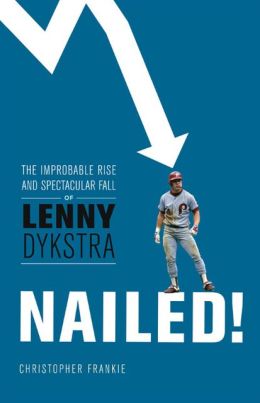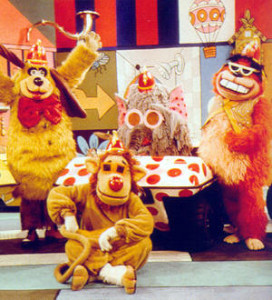
When reading “Nailed!: The Improbable Rise and Spectacular Fall of Lenny Dykstra” by Christopher Frankie, a one-word question bounced through my head: Why?
It’s never easy to work for a boss who is uncompromised and inconsistent, but when that boss was one of your childhood heroes, it becomes even more difficult to leave your position. And this is what Frankie found out in his short-term employment to one of baseball’s most popular players, Lenny Dykstra.
As a centerfielder for the New York Mets and the Philadelphia Phillies, Dykstra brought a combination of intensity and grit to every game he played in. He may not have been the most talented ballplayer, but he got the most out of his abilities through hustle, hard work and as the reader finds out in this book, some PEDs.
When Dykstra left the game, there was no one who thought that he had the brains to enter the working world. Most thought that he’d end up a coach somewhere, living off his name and past glories. However, Dykstra had other ideas; he was going to buy and run upscale carwashes in his native Southern California.
Once those businesses turned a profit, Dykstra sold out and began dumping his money into the stock market—specifically in stocks that he had chosen. According to Frankie, Dykstra spent an entire year immersing himself into the world of high finance and came out with an understanding of that world and a system for choosing stocks. His acumen for picking winners was so great that he began to attract the attention of prominent Wall Street analysts like Jim Cramer.
It’s here where the book picks up as Frankie was hired by Dykstra to work on his columns and newsletters for a financial publishing company. Not only that, but Frankie was given the title of Publisher (despite being in his early 30s at the time) of Dykstra’s new magazine venture. Called “The Player’s Club”, this periodical was aimed at professional athletes and had articles tailored to their lifestyles: when and how to retire, procuring a private jet, preparing for life after the applause ends. It was an ambitious project that definitely filled a niche, but Dykstra was too erratic to make it work and his mini-empire began crashing down on him.
Unfortunately for Frankie, he was part of the collateral damage. Late night phone calls from a barely coherent Dykstra, midnight meetings that lasted until dawn, screaming, caterwauling, charges of blatant racism and sexism were some of the trials that Frankie had to endure. Despite telling everyone that buck stops with him, Frankie alleges that Dykstra never took responsibility for his mistakes, stole money from his employees (when he decided to pay them) and was a general loathsome individual to be around. Midway through his partnership with Dykstra it finally dawned on Frankie that Nails (as Dykstra was known in baseball) maybe wasn’t the right star to attach his wagon.
I had followed this story pretty closely when it broke, so I had a good idea of the things that Dykstra did and the shop that he ran, however “Nailed!” goes into deeper detail about the travesty of working for Mookie Wilson’s former platoon partner.
About mid-way through the story I found myself muttering the one-word question that I referred to in the opening paragraph, “Why?” Why did Frankie stick around this long? Why couldn’t Frankie understand that Dykstra was using him and pretty much everyone he ever came in contact with? Despite dealings with countless people who were burned by Nails in the past, why did Frankie think that it would be different with him?
And to be fair, Frankie does address these questions. It seems that there’s a bit of hindsight spin on his part, but it’s understandable. The basic gist is two-fold: Dykstra owed him a ton of cash (for his work, Frankie never let him borrow his credit card, like other employees) and he felt that he owed the people whom he brought into Dykstra’s operation. On the last point, he didn’t want to leave anyone in this morass of insanity. And to his credit he was able to recoup a portion of his owed wages and help the other two members of the Dykstra staff (which numbered two by the end of the year) to escape with some cash.
The one thing that I found most interesting about this book is that despite Frankie being mistreated and taken advantage over and over again, there is still a shred of him that looks up to Dykstra. Whether it’s the even hand of a good journalist or someone feeling the lingering effects of Stockholm Syndrome, Dykstra isn’t portrayed as someone who is all bad. To me, that would be the biggest difficulty to writing this book and Frankie does a nice job of showing not only the detestable things that Dykstra would do, but also some of the reasons why a person would put up with this crap. Like most con men, Dykstra has a healthy amount of charisma that charm folks that don’t know him very well. It’s only after one has been caught up in the Dykstra web then does the real personality show.
Aside from Dykstra’s Girl Friday, known as Dorothy, is the most compelling character in this passion play. As someone who has been with Nails since the beginning of his business forays, she has seen him at his best and his worst. And despite treatment that borders on violations of Geneva Treaty, she keeps returning to him. She acted as Frankie’s Yoda and helped him navigate through the first few months of Lenny’s insanity.
For his first book, Frankie did a really good job. “Nailed!” was a quick read but at the same time made it impossible to put down. After a few books that didn’t live up to expectations, it was nice to find a tome that not only lived up to its billing but surpassed it. If you’re a fan of baseball, get the book. If you’re interested in just how screwed up our financial climate is and who we listen to in order to get rich, get the book.
You won’t be disappointed.



